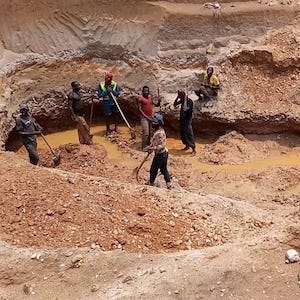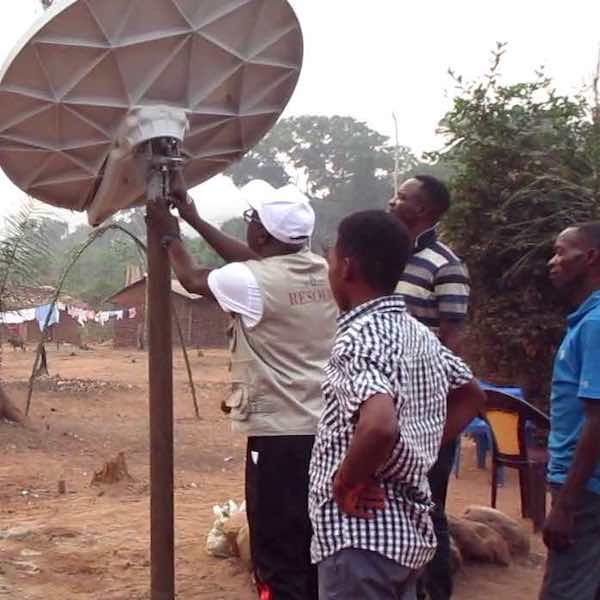
Coomiap is a small village in the Democratic Republic of Congo (DRC)—and it may even be a stretch to call it a village. It’s built entirely around the local mine after which it’s named.
Its 137 residents get by with no electricity and live in what can safely be called the middle of nowhere. The biggest town, Kananga, is six hours away—and the only way it can be reached is by motorbike, since the area has no paved roads.
“There are only woods and a few huts nearby,” says Pieter Bombeke, a third-generation veteran Antwerp, Belgium, cutter.
The village does its own farming, which means it’s largely self-sustaining. And it also has diamonds—enough to possibly make a difference in the lives of local residents.
Emile Ekonda-Elasha, a Belgium-based DRC native whose brother runs the mining cooperative, believes the mine won’t run out of diamonds for the next 100 years. But it’s always had trouble getting full value for its product.
But now, thanks to OrigemA, a new program backed by the Antwerp World Diamond Centre (AWDC), the cooperative has been given full access to the Antwerp market. And it’s already noticed a difference.
“This is the first Congolese cooperative that does exports,” says Bombeke. “All the other merchants pay peanuts for the rough they find. We wanted to get them get real value.”
Dutch gemologist Peter Groenenboom, a partner on the project, says when he visited the DRC he found a sharp difference between local and DRC prices.
“One of the last days I [visited DRC, I] was offered very nice octahedral for 1.6 carat, very good quality for only $100. If I could bring it to Antwerp, I would get something like $1,600 euros for it.”
It’s the latest example of a fair trade project that has used artisanally mined resources to benefit the local population. Other examples include Fairmined gold, Moyo Gems, and De Beers’ GemFair. Along with GemFair, it’s one of the first projects in the diamond sector to come to market, even though fair trade diamonds have long been a holy grail of the responsible jewelry movement.
Coomiap is one of the six DRC cooperatives the AWDC has selected for its OrigemA pilot. It’s considered the most advanced as far as standards, which is why it was included in the initial batch.
All the co-op mining is done to the Diamond Development Initiative/ Resolve’s Maendeleo Diamond Standards. A local representative of the ministry of mines vouches for their provenance—though there’s a plan to work with Everledger to have the diamonds tracked by blockchain.
Blockchain could be a problem, admits Karen Rentmeesters, AWDC senior manager, PR and communications, given the village lacks electricity. But the project is working to install solar-powered Wi-Fi.
“The idea is to create something that would maximize the value,” she says. “Traceability is part of the story. We need the blockchain is to testify to the story.”

A bigger problem has been getting the co-op a proper export license, which in the DRC, costs $250,000. That is one reason why buying there has traditionally been limited to small, select group.
For the moment, the AWDC has arranged for the diamonds to be sold through a local licensed company, but Rentmeesters hopes that the DRC will eventually lower the fee for the hundreds of small DRC coops.
The AWDC is helping the village learn how to properly value its rough and to maximize value from the mine tailings. “They have been unaware of the value of the smaller diamonds,” she says.
Most of its diamonds are sold with three custom cuts that Bombeke developed for this project: the Little Dragon, a round brilliant but with more facets on the pavilion, meant for the Asian market; Jacob’s Ladder, a modified round with rows of steps; and Dreamcatcher, a double- checkerboard shape named for the Native American talisman.
The new project doesn’t have much of a brand name or marketing presence—it’s still too small. So far, the cooperative produces only about 30 or 40 a year.
“Supply of the rough is where it gets tough,” says Groenenboom. “For the moment, we work with one cooperative. You need organization and the security of a steady supply. That’s one of the things that is lacking at the moment.”
Ekonda-Elasha hopes to use any extra proceeds build a small school and hospital in the nearby town of Luyamba, which will serve the village and surrounding communities. (There are 1,200 school-age children in the area, and the only local school was destroyed during an outbreak of violence in 2016.)
It’s a beguiling, feel-good story, which is why the people behind it say marketing is probably the least of their problems.
“I am seeing more interest in the wider market rather than just those who have specialized in ethical or fair trade products,” says Matthew Morrell, managing director of London-based Direct Source Gems, one company selling the diamonds. “I think that hinges on the full traceability, the close chain of custody.”
Agrees Rentmeesters: “There’s a lot of interest from small players, big players, who basically say in today’s world, if you can give me all that provenance information I’m willing to buy everything.”
Top: Miners in the Coomiap village in the Democratic Republic of Congo (photos courtesy of Antwerp World Diamond Centre)
Follow JCK on Instagram: @jckmagazineFollow JCK on Twitter: @jckmagazine
Follow JCK on Facebook: @jckmagazine





